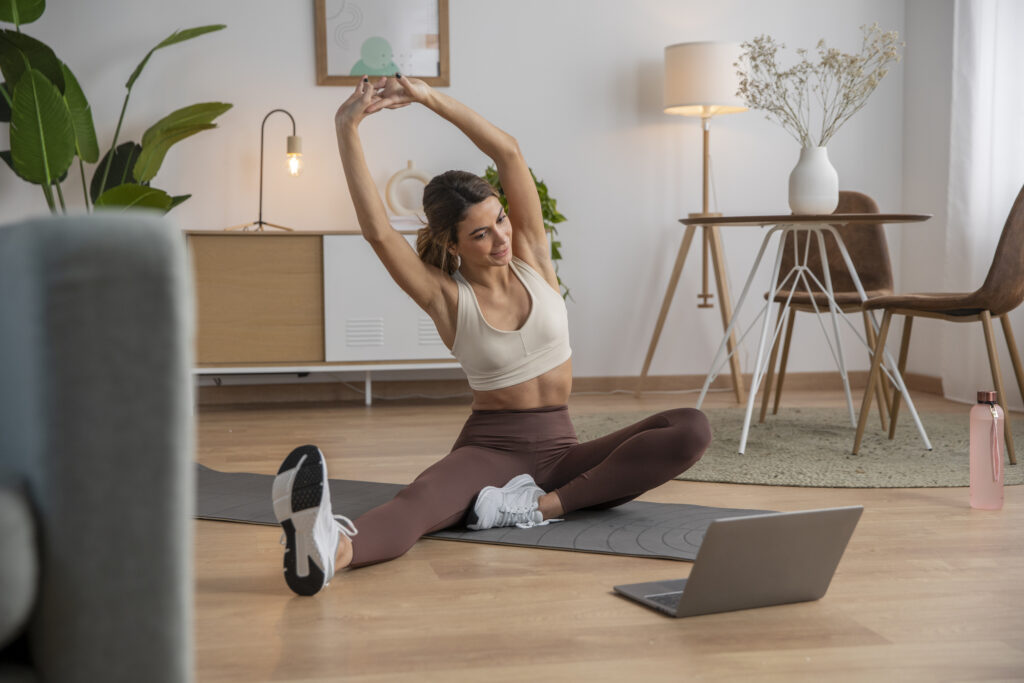If you're spending long hours at a desk, you might be familiar with the discomfort that comes from poor posture. It's easy to overlook how your workspace setup affects your body, but making a few adjustments can lead to significant improvements. From selecting the right ergonomic chair to optimizing your desk height and monitor placement, there are practical solutions that can alleviate strain. Curious about how these changes can enhance your daily comfort and productivity? Let's explore the top seven strategies to tackle those desk job posture issues effectively.
Ergonomic Chair Selection
Choosing the right ergonomic chair can greatly impact your comfort and productivity while working. When you sit for long hours, the chair you choose plays an essential role in maintaining proper posture and reducing fatigue.
Look for a chair that offers adjustable features, such as seat height, backrest angle, and armrest height. This customization helps you find the perfect fit for your body type.
Consider the lumbar support of the chair. It should provide adequate support for your lower back, promoting a natural spine curve. A chair without proper lumbar support can lead to discomfort and long-term health issues.
Test different chairs to see which one feels most comfortable and supportive.
Also, pay attention to the seat material. A breathable fabric can keep you cool during long work sessions, while a cushioned seat prevents pressure points from forming.
Don't underestimate the importance of a swivel base and wheels; these features enhance mobility and allow you to reach different areas of your desk without straining.
Lastly, think about the chair's overall style and how it fits into your workspace. You want something that not only serves a functional purpose but also complements your office aesthetic.
Desk Height Adjustment
When it comes to maintaining good posture during long work hours, adjusting your desk height is essential. A desk that's too high or too low can lead to slouching, hunching, or straining your neck, which can cause discomfort and even long-term injuries. Finding the right height helps keep your body aligned and supports a healthier work environment.
To determine the ideal desk height, start by sitting in your ergonomic chair with your feet flat on the floor and your knees at a 90-degree angle. Your elbows should also be at a 90-degree angle when your hands rest on the keyboard. If your chair is adjustable, you can tweak its height to achieve this alignment.
If your desk is too high, consider using a footrest to support your feet and maintain proper posture.
If you can't adjust your desk, think about using a keyboard tray. This allows you to lower your keyboard to the right height while keeping your monitor at eye level.
Another option is to use a standing desk converter, which lets you alternate between sitting and standing throughout the day, reducing the strain on your back and neck.
Proper Monitor Placement
After adjusting your desk height, the next step is ensuring your monitor is positioned correctly. Proper monitor placement can greatly affect your comfort and productivity throughout the day.
Start by positioning your monitor at eye level. You shouldn't have to tilt your head up or down to see the screen. Ideally, the top of the monitor should be at or slightly below eye level, allowing you to maintain a neutral neck position.
Next, keep the monitor about an arm's length away from you. This distance helps reduce eye strain and allows you to view the entire screen without excessive eye movement. If your monitor is too close, you might find yourself leaning forward, which can lead to poor posture and discomfort.
Also, consider the angle of your monitor. Tilt it slightly back—about 10 to 20 degrees—so that you're looking down at it rather than staring straight ahead. This positioning encourages a more natural posture and helps prevent neck and shoulder tension.
Lastly, avoid glare from windows or overhead lights. Position your monitor to minimize reflections, as glare can cause you to squint and strain your eyes. You might also want to invest in an anti-glare screen if necessary.
Keyboard and Mouse Position
To maintain ideal posture while working, your keyboard and mouse should be positioned to support a natural alignment of your arms and wrists. When you sit at your desk, your elbows should be close to your body, forming an angle between 90 and 120 degrees. This setup reduces strain and helps prevent discomfort during long hours of typing.
Here are some tips to achieve the perfect keyboard and mouse position:
- Keep them at the same level: Your keyboard and mouse should be on the same surface to avoid unnecessary reaching or lifting, which can lead to tension in your shoulders.
- Position them close: Place your keyboard and mouse within easy reach to minimize arm stretching. This helps maintain a relaxed posture.
- Use a wrist rest: A wrist rest can provide support and comfort, ensuring your wrists stay straight while typing. Just make sure it doesn't raise your wrists too high.
- Tilt your keyboard: If your keyboard has adjustable legs, consider tilting it slightly. This can help keep your wrists in a neutral position and reduce strain.
Regular Stretch Breaks
Maintaining proper keyboard and mouse positioning is important, but it's just as essential to incorporate regular stretch breaks into your work routine. Sitting for long periods can lead to stiffness and discomfort, affecting your overall productivity and well-being.
By taking short, intentional breaks to stretch, you can alleviate tension and improve your posture. Set a timer to remind yourself to take a break every hour. During these breaks, stand up, move around, and do some light stretches.
Focus on your neck, shoulders, back, and wrists, as these areas often bear the brunt of prolonged desk work. Simple stretches, like neck rolls, shoulder shrugs, and wrist flexes, can greatly reduce tightness and increase blood flow.
Incorporating movement into your day doesn't have to be time-consuming. A quick five-minute walk around your office can do wonders. If you can, step outside for fresh air; the change of scenery can refresh your mind and enhance focus.
You might also consider simple exercises like leg swings or calf raises while waiting for the coffee to brew or during phone calls.
Footwear Considerations
When you're at your desk for hours, the right footwear can make a big difference in your comfort and posture.
Supportive shoes with the right heel height can help reduce strain on your feet and back, while high-quality materials guarantee durability.
Choosing the right shoes is essential for maintaining good posture throughout your workday.
Supportive Shoe Styles
Finding the right footwear can make a world of difference in how you feel during long hours at your desk. Supportive shoe styles can help reduce fatigue and improve your overall posture.
You want to prioritize comfort and stability, so choosing shoes that provide adequate support is essential. Here are some styles to contemplate:
- Athletic Shoes: Designed for movement, they often feature cushioned soles and good arch support.
- Loafers with Arch Support: These can be stylish yet functional, offering support without sacrificing professionalism.
- Ballet Flats with Cushioned Insoles: Look for options that come with extra cushioning to keep your feet comfortable.
- Sneakers with Good Sole Support: Trendy sneakers are now available with enhanced support and cushioning, making them perfect for a desk job.
Heel Height Importance
The right heel height can greatly impact your comfort and posture during long hours at your desk. When you choose footwear with an appropriate heel height, you help maintain a natural alignment of your spine, which can reduce the risk of back pain and discomfort.
Generally, a heel height of one to two inches is ideal for desk jobs. This height provides enough lift to promote good posture without causing strain on your feet or legs.
Higher heels can lead to an unnatural angle in your foot and leg, which may result in issues like fatigue and even chronic pain over time. On the other hand, flats mightn't provide enough support, causing your body to slouch or lean forward.
When selecting shoes, consider styles that offer a slight heel while still providing adequate arch support. This balance can help you stay comfortable and focused throughout your workday.
Material Quality Matters
Choosing the right heel height is just one aspect of ensuring comfort at your desk; material quality also plays a significant role in your footwear's performance.
When you're seated for hours, the materials in your shoes can either enhance your comfort or lead to unnecessary discomfort. High-quality materials provide better support, breathability, and durability, which are essential for long days at work.
Here are some considerations to keep in mind when selecting your footwear:
- Breathable Fabrics: Look for shoes made from materials like leather or mesh that allow your feet to breathe and reduce sweat.
- Cushioning: Opt for shoes with adequate padding. Memory foam can make a world of difference in how your feet feel throughout the day.
- Flexibility: Choose materials that offer flexibility, allowing your foot to move naturally without feeling restricted.
- Weight: Lightweight shoes can prevent fatigue, making it easier to stay focused and energized during your work hours.
Posture Awareness Techniques
Many people struggle with maintaining good posture throughout the workday, but developing posture awareness techniques can greatly improve your comfort and productivity. The first step is to check in with your body regularly. Set a timer on your phone for every hour to remind yourself to pause and assess your posture. Are your shoulders slumped? Is your back straight?
Another effective technique is to visualize good posture. Picture yourself standing tall with your shoulders back and your head aligned with your spine. This mental image can help you adjust your position when you're seated. You might even consider placing a sticky note on your monitor that says "Posture Check!" to keep this awareness front and center.
Engaging in simple stretches can also enhance your posture awareness. Every time you take a break, stand up and stretch your arms overhead, and gently twist your torso side to side. This not only relieves tension but also reinforces the feeling of being upright.
Finally, practice mindfulness. Being present in your body means you're more likely to notice when you're slumping or leaning forward. Incorporate short mindfulness exercises into your day, focusing on your breath and how your body feels in your chair.
Conclusion
By implementing these seven solutions, you can greatly improve your posture and overall well-being at your desk job. Investing in an ergonomic chair, adjusting your desk height, and ensuring proper placement of your monitor, keyboard, and mouse are essential steps. Don't forget to take regular stretch breaks and wear supportive footwear. Finally, stay mindful of your posture throughout the day. With these strategies, you'll not only feel better but also boost your productivity and comfort at work.

